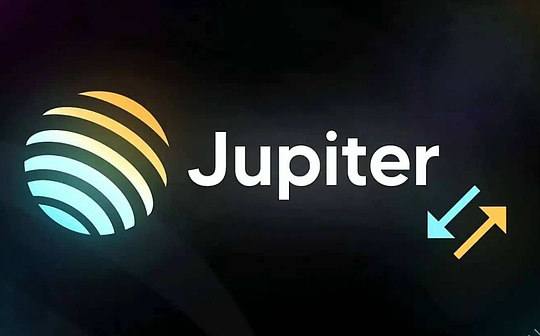
Author: Frontier Lab Chinese Source: X,@Frontierlab_zh
introduction
Jupiter was founded in 2021. His project positioning is a decentralized transaction liquidity polymer on the Solana blockchain. After 3 years of development, the Jupiter has brought together more than half of the transaction volume on the Solana chain. It can be said that it has already already beenIt has developed to the ceiling level of the trading polymer on the Solana chain. There is no more room for development on the trading polymer of the project’s main item, so it has begun the development direction of the horizontal development business, and the Launchpad platform Jupiter has been launched.Start and the incubator Jupiter Labs, the purpose of incubating other high -quality projects to achieve the horizontal development of Jupiter in various parallel areas.
Basic project information
Basic information
Website: https://jup.ag/zh-sg
Twitter: https://twitter.com/jupiterexchange, 420,000 fans
Reddit.:https://www.reddit.com/r/jupiterexchange/
Discord: https://discord.com/invite/jup
White Paper: https://stative.jup.ag/docs
Line time: tokens were launched in 2024
Project team
Core team
Meow: Co -founder.He also built Meteora and R.A.C.C.O.O.N.S.He is also the co -founder of the largest Wrapped token WBTC, and is also one of the founders of the Handshake project.
Ben Chow: Co -founder.With many years of interactive design and product experience, one of the founding team members of social game company Hive 7, the company has obtained True Ventures’s Series A financing.In 2010, Hive 7 was acquired by Disney/PlayDom.At the end of 2007, he helped design and launched Hive 7’s popular social game Knighthood.
Consultant team
Shun Fan Zhang: Phala Network White Paper Author, one of the authors of the Funteg University Software and Security Laboratory, has published research on attacking and defensive means in the Usenix Security of the top international security conference, and published multiple articlesInternational top security conference paper.
Sandro Gorduladze: Hash CIB’s angel investors and partners.Sandro set up a research department in Hash, which is famous for its in -depth reports.Before joining Hash, Sandro worked in Pwori, Russia to provide tax consulting for companies in the TMT industry.
Konstantin Shamruk: Doctor of Economics at the University of Toulouse, France.Leading Phala Network’s analysis of the Benmun’s economic design.
Jonas Gehrlein: WEB3 Foundation Research Scientist.He is responsible for studying the economic problems of the Polkadot ecosystem at the Web3 Foundation.Before joining W 3 F, Jonas obtained a doctorate in the behavior of Berne University and an experimental economics, where he studied human behavior in the market and organization.Prior to this, he received a master’s degree in quantitative economics at the University of Constitz.
Zo Meckbach: Polkadot Senior Ambassador, researchers and advocates of Web3 and network security.She is currently a COO of MH-IT & amp; Service GmbH, and she served as Google’s application analysis position before joining MH-IT.
Financing situation
The Jupiter team did not announce any financing information.
Development strength
Jupiter was established in 2021, founded by co -founders Meow and Ben Chow.The key event of the project development is shown in the table:
>
Judging from the Jupiter’s project development roadmap, although the Jupiter team has achieved great success after the project was launched, it can still continue to provide innovative functions to the project, continuously optimize the user’s experience, and be able to trade in their main business transactionsAfter the polymer reaches the extreme on the Solana chain, it can quickly discover and change the thinking extension of other parallel services. It can be seen that the Jupiter’s project team has a keen business insight and aggressive spirit, and it can also be completed in a timely manner in technical development.Development task.
Main product
Trading polymer
The trading polymer is the core product of Jupiter, and it is also the success of Jupiter.The trading polymer is a type of DEFI project in the previous round of bull market. Because the last round of the bull market was ignited by the summer summer, many traders at that time gathered on the chain to use various DEX for token transactions.However, DEX has an obvious flaw, that is, each DEX has its own liquidity pool. The liquidity pools of each DEX are not interoperable, so when investors are conducting transactions, they often need to find the best themselves themselves themselves.To obtain the optimal transaction price, this is not only time -consuming and laborious, but also due to the dispersion of liquidity, it is difficult to ensure the optimality of the transaction.
However, the current situation is changed after the appearance of the transaction polymer. The trading polymer can aggregate the liquidity pool of different DEX on the same chain. Users can clearly see that when using a trading polymerIn the depth and slippery point of all pools in the market, traders can choose to choose the dex that suits them according to their needs.
Jupiter is to aggregate many liquidity pools in the Solana ecosystem, and automatically find and aggregate the optimal liquidity resources through algorithms to provide users with one -stop optimal trading path.Jupiter’s operating interface is very friendly, which is more like Uniswap’s trading interface, so that most users can adapt to and familiar with them.Before operating Jupiter, users can set up various parameters of transactions according to their needs, such as transaction costs, trading sliding points or trading paths, so that users can choose the most suitable price and slippery point for their own.Jupiter is mainly monitored and analyzed in real time through its own intelligent contract algorithm. Through the real -time monitoring and analysis of the market data, Jupiter will intelligently help users choose the optimal transaction path in the market to improve the success rate of user transactions and the success rate andFunding efficiency.
Among them, in order to ensure traders’ security and transaction quality, Jupiter requires a minimum of $ 500,000 to the pair of transactions in the Jupiter, and must be audited by strict audit.Because of the above reasons, Jupiter aggregates most of the transaction volume on Solana, and now it can occupy more than 50%of the transaction volume on the entire Solana chain, occupying the absolute dominant position on the Solana chain.
Limit list
Solana puts its main development positioning on the trading chain, and because the unique consensus mechanism and SVM parallel ability of the Solana chain make traders very friendly, many traders choose to trade on the Solana chain.Because Jupiter itself is served for traders, it provides traders with a function of limited price, which helps traders effectively avoid the cost increase and slippery point caused by price effects during transaction, while avoiding the MEV problem.
Jupiter’s friendship with users is also reflected in the interface operation. Jupiter collaborated with Birdeye and TradingView. Birdeye provides Jupiter to provide token chain price data, and Jupiter uses TradingView technology to display chart data, which makes Jupiter’s operation interface andThe traditional CEX interface is very similar, so that users can more adapt to the Jupiter’s operating interface, providing users with a better sense of experience.
In specific use, the price limit is set to tokens that can be partial transactions and obtained the transaction part.When proposing a transaction, users can choose the validity period, exchange price, and the number of redeefs to perform their own trading strategies.As a result, users can more conveniently avoid the cost increase and slippery problem caused by price impact during transaction, while avoiding the MEV problem.
DCA fixed investment
Dollar-Cost Averaging (DCA) is a kind of investment strategy that uses a lot of investment in reality. Users can reduce their buying costs in the future and fixed investment in the future to their expected price range.This method can help investors reduce investment risks of a single price in a large market environment.Jupiter provides DCA fixed -investment products. Users only need to set their own purchase frequency, purchase price range, total time period, and currency hopes to buy.After the fixed investment is effective, the tokens purchased by the user will be transferred to the user’s own account in Jupiter, and transaction is automatically executed according to the preset price interval and transaction frequency.After the fixed investment is over, tokens will be automatically transferred back to the user wallet.
Jupiter’s DCA has the advantages of controllable costs, low costs, and full -hosted transaction processes.Since the middle of Xiong City, DCA is very friendly to traders. Due to the large price fluctuations and high uncertainty, DCA can allow investors to evenly buy assets at a lower cost price for a period of time, thereby reducing the single timeThe risk brought by investment.In addition, DCA can help investors avoid the emotional impact of market fluctuations and maintain a rational and stable investment strategy.However, in the bull market, DCA’s advantages no longer exist.Because the market is on the rise, a single investment can often obtain higher returns, so the use of DCA fixed investment may not be able to fully seize the opportunity of the market’s rapid rise.
Therefore, DCA, as a long -term investment strategy, has certain advantages in a specific market environment.However, due to certain requirements for market trends and cycles, the overall demand of this function is relatively small.When investors choose to use DCA fixed investment, they need to take comprehensive considerations based on their own risk preferences, market environment, and long -term investment plans.
Jupiter Labs
Jupiter Labs is an independent project investment laboratory operating independently in Jupiter. His operation is based on the promotion of himself and the community, and is not affected by the Jupiter project party.Therefore, Jupiter users and community members have certain priority, including priority use rights and tokens incentives.
Jupiter Labs is a manifestation of Jupiter’s starting business.Through investment support for various horizontal fields, the proportion and influence of horizontal expansion in the entire Solana ecosystem is achieved. At this stage, Jupiter Labs is committed to the development of the two projects of perpetual contracts and LST stablecoin.Similarly, we can know that perpetual contracts and LSD stablecoins are the two most profitable and influential areas in the ecology.
Sustainable contract
Jupiter Perpetual is the first step for Jupiter to move towards perpetual contracts. His operating mode is similar to GMX. The participants in Jupiter Perpetual are: liquidity providers and traders.Lleap providers provide funds to the pool. These funds are converted into a package of tokens, mainly including BTC, ETH, SOL, USDC, and USDT. Among them, SOL and USDC occupy higher weights and become the main transaction objects.When traders conduct leverage trading, they use tokens in the liquidity pool to establish leverage positions. Traders need to pay transaction fees and borrowing fees.Lobricity providers obtain 70%of transaction fees and all borrowing fees.The same as GMX is the liquidity provider, which is the opposite of the trader in the transaction. The trader’s contract trading is the opponent’s disk of liquidity providers.Therefore, this model will have a lot of liquidity providers in the bear market, but the bull market is not very friendly to liquidity providers.
Jupiter Perpetua supporting traders can use the highest 100 -fold leverage to pay the contract with a permanent contract, while LP can provide funds to earn fees.In a perpetual contract, traders can bear larger positions with less capital distribution (leverage) in order to use future price fluctuations.In Jupiter Perpetua, traders can use almost any supported Solana tokens as mortgages, and open long or short positions on SOL, ETH, and WBTC.The multi -header requires the corresponding target, and the short position requires stable currency as a mortgage.Traders can borrow assets from the liquidity pool to assume leverage.
LST stablecoin
XYZ is a LST stable currency project supported by Jupiter Labs. In XYZ, users can use mortgage SOL to cast non -loan interest on interest and interest. The user’s mortgage is locked in a smart contract until the user repaid the corresponding SUSD.This loan model allows users to obtain stable coins without the borrowing interest.And the income obtained by XYZ through LST pledge will be assigned to SUSD holders and governing token holders to motivate more users to actively participate in the agreement.In addition, the XYZ agreement also uses leverage arbitrage strategy to maximize the income.When the LST yield is higher than the SOL borrowing interest rate, users can adopt leverage arbitrage strategies to obtain higher returns.XYZ is also similar to LYBRA’s use of the redemption mechanism to maintain the price of SUSD. In order to reduce the impact on the borrower’s position, XYZ adopts the method of governing tokens in a small price interval for SUSD redemption. When the price of SUSDAt the time of 0.95-1, XYZ used SUSD to redeem tokens to reduce the frequency of borrower being redeemed.
Jupiter lfg launchpad
LFG LAUNCHPAD uses an innovative way to support new projects, emphasizing a model with community -driven and transparency as its core.Traditional project launch platforms often have complexity, while LFG LAUNCHPAD abandons this complexity and adopts the method of opening up the market and community participation.At the same time, the platform also gave up a complex incentive structure and isolation price discovery mechanism, highlighting its unique features.The core advantage of LFG LAUNCHPAD is its huge community support, customized Launchpad to prevent robotic operations, user -friendly design tools for liquidity management, and comprehensive trading functions.These features ensure that users can find fair prices and instant fluidity, while providing better support for technical aspects.First, LFG Launchpad relies on huge community support to promote the development of new projects.The community -driven model enables the project to get wider attention and support, providing a broader development space for new projects.Secondly, LFG Launchpad uses customable Launchpad to prevent robotic operations, effectively ensuring the fairness and transparency of transactions.This feature makes transactions more safe and reliable, effectively avoid malicious manipulation and improper intervention, and provides users with a more stable and reliable trading environment.In addition, LFG Launchpad also provides user -friendly design tools for liquidity management, allowing users to manage their assets and liquidity more conveniently.This feature is conducive to improving the user experience and providing users with more convenient and efficient operation methods.Finally, LFG Launchpad has a comprehensive trading function, providing users with richer and diverse transaction options.Whether it is a trading type or a transaction variety, users can find a transaction method that meets their needs on LFG Launchpad, which is conducive to improving transaction efficiency and meeting the user’s personalized needs.
And Jupiter’s co -founder Meow, the H 2 plan mentioned in the media recently, clearly affirmed the improvement of LFG Launchpad on the influence of the Jupiter brand, and it is expected that in the third quarter, Jupiter will surround the rules and development of LFG Launchpad will be.Continue to explore and develop in -depth.
Compared with the same track project
Jupiter, as the most successful decentralized transaction liquidity polymer in the Solana ecosystem, has occupied half of the transaction volume in Solana, so its main competitor is decentralized trading liquidity polymer giant in Ethereum ecosystem.Essence
Underground operation logic
Jupiter is a decentralized transaction liquidity polymer running on the Solana chain. It enjoyed the high performance advantage on the Solana chain. The main manifestation is the use of SVM.SVM supports the smart contract code written by Rust, C, C ++. After accessing SVMability.The Sealevel engine is a key component implemented on parallel processing on Solana, and the state access list is integrated as the Solana transaction, which allows unconventional transactions to run at the same time to achieve faster overall performance.SVM supports multi -threading, which can handle more transactions in a shorter time.Each thread contains a trading queue waiting for execution, and the transaction is randomly assigned to the queue.This makes Jupiter have very strong transaction processing capabilities, can support huge number of trading operations at the same time, and is very friendly to trading users.
1Inch is a decentralized transaction liquidity polymer running on the Ethereum chain. The underlying logic of its operation is based on EVM, and EVM is a single -threaded operating environment, which means that it can only handle one contract at a time, so asAs a result, it cannot be compared with Jupiter in handling transactions.Although Ethereum experienced the upgrade of Cancun in 2023, coupled with the proposal of its various L2 solutions, it improved the performance on Ethereum, but it was still unable to compare with Solana.As a result, Jupiter has an advantage in performance compared to 1Inch.
GAS fee
Decentralized trading liquidity polymer is a high -frequency chain trading behavior, which makes users very sensitive to GAS.The Solana chain adopts the consensus method of historical proof, improves the efficiency and reliability of the system, and uses SVM to allow Solana to have a very high processing speed and low latency, which allows the transaction to quickly recognize, thereby reducing the GAS that needs to be paid.cost.Based on this point, the trading user of Jupiter only needs to pay a cost of $ 0.00015 per transaction, which is enough to support users to use high -frequency operation to complete their own trading strategies.They all play a vital role.
Although the Ethereum has declined after the upgrade of Cancun, the average trading fee on Ethereum also reached $ 0.3 per pen, which is far higher than the GAS fee on Solana.Then 1Inch, a decentralized transaction liquidity polymer, is essentially a high -frequency chain trading behavior.The GAS fee paid by the transaction users will double with the frequent trading behavior, so that during the bull market, it is very unfriendly for trading users, and the essence of the polymerUsers provide better prices instead of only obtaining a specific DEX, and then the high GAS fee on Ethereum will make the use of trading polymers from multiple different pools.The problem that the deterioration originally wanted to solve may be more favorable in transactions in only one place.
Diverse product
Jupiter provides a variety of products for trading users, such as price limit orders, DCA fixed investment, and derivatives transactions, which can meet the different use needs of users.In this regard, Jupiter can be said to be the most likely to help customers solve various problems encountered in the transaction.Comprehensive financial services can not only meet the various financial needs of users, but also provide the most suitable financial services for trading users at various market stages.
The 1INCH is slightly single in terms of products. 1Inch only focuses on the product positioning of the DEX polymer, so that it only provides a better price for trading users by obtaining liquidity from multiple sources, and does not provide other financial service products.
Future development direction
Jupiter has already occupied an absolute faucet position in the decentralized trading liquidity polymer track in the Solana ecosystem. Its development space on the original track is not large, so it has shifted its sights to other parallel tracks, so it launched the launchJupiter Labs and LFG LAUNCHPAD have increased their influence by supporting and investing in different tracks in other Solana ecosystems.Therefore, from the perspective of future development, in addition to continuous updating and increasing various functions in its own liquidity polymer, Jupiter’s development focuses on promoting Jupiter Labs and LFG Launchpad. In its co -founder in H 2The work plan clearly specifies that Jupiter will continue to explore and develop the rules and development around LFG Launchpad.
Although 1INCH occupies a major position in the decentralized transaction liquidity polymer track in the Ethereum ecosystem, it is not like the absolute dominant position of Jupiter in the Solana ecosystem, because Uniswap is a very very in the Ethereum ecosystem in Ethereum ecology.Successful DEX, Uniswap also gathered quite a lot of users.Therefore, the 1INCH development route is different from the Jupiter. The 1INCH mainly cultivates the business of decentralized trading liquidity polymer tracks. By deploying its own L2, the speed of transaction and GAS fees optimize it.Adjustment.
Project model
Business model
Jupiter is a decentralized trading liquidity polymer and also provides derivative contract services and project incubation. Therefore, the Jupiter economic model consists of three roles: trading users, liquidity provides users, and new incubation items.
Trading users: Trading users are the basis for the success and development of the Jupiter project. Trading users enjoy various financial services projects on the Jupiter platform, such as liquidity aggregation, price limit, DCA fixed investment, and contract services.To this end, pay a certain percentage of transactions and service fees to Jupiter, which is also the main source of revenue from the Jupiter project.
Liquidity provides users: Because Jupiter not only limits its own designed business to liquid polymerizers, Jupiter extends out to a perpetual contract. The operation of its operation is similar to GMX, so it must have users who provide liquidity.To ensure the normal operation of permanent contracts, 70%of transaction fees and all borrowing fees from medium liquidity providers, and the remaining 30%as the source of income for the Jupiter project.
New incubation project: After Jupiter launched LFG Launchpad, a innovative method is used to support new projects. Among them, Jupiter not only provides technical support, but also provides certain financial support.It is also a source of income from the Jupiter project.
From the above analysis, it can be seen that Jupiter’s income is:
-
The cost of using Jupiter’s liquidity polymer is within 2%, and the cost depends on different liquidity pools.
-
Using Jupiter’s price limit single function, users need to pay 0.3%.
-
Using Jupiter’s DCA fixed investment function, users need to pay 0.1%.
-
Using Jupiter’s permanent contract products, it takes 0.1%to open the position/liquidation, and the exchange fee needs to be paid within 2%(according to the weight of the pool), the borrowing rate is 0.01%/hour*token utilization%and 30%of 30%Trading fees and all borrowing fees.
-
Projects incubated or operated by Jupiter Launchpad allocated their own tokens to Jupiter.
Token model
According to the white paper, the total amount of JUP is 10 billion pieces, and now the circulation is 1.35 billion pieces, and the circulation rate is 13.5%.The initial circulation was 1.35 billion pieces, of which 1 billion were used for airdrops, 250 million were used for Launchpool, and 50 million were used for CEX to make LP demand on the market and chain.The overall tokens are allocated as follows:
>
The agreement promises to allocate 50% tokens to the community and allocate a cold wallet to the team and the community. The initial circulation tokens are expected to add 5% of liquidity and 10% of the airdrop tokens (there may be additional additional ones may be additional ones.About 2% tokens unlock).
Tokens
According to the white paper, Jup’s purpose in Jupiter is as follows:
-
Governance Certificate: Jup token holders can participate in the DAO (decentralized autonomous organization) governance of the Jupiter platform, and affect the operation and development direction of the protocol through voting.
-
Liquidity mining: Users can earn the Jup token reward by providing liquidity to the Jupiter’s liquidity pool to inspire users to increase platform liquidity, reduce transaction slippery points, and improve transaction efficiency.
-
Fee fee discount: users holding Jup can enjoy a certain degree of handling fee reduction and exemption when using Jupiter for transactions, which further enhances the practical value of tokens.
-
Extension function: With the continuous evolution of the Jupiter platform, the function of Jup token is also continuously expanding. For example, users may be able to use Jup to participate in the preferential use rights of sustainable contract transactions or obtain new products and services.
Jup’s value judgment
According to the White Paper, in the Jupiter project, Jup does not have a scenario of centralized destruction or regular destruction, and pledge submissions.
The less empowerment of JUP is a significant disadvantage of the Jupiter project. It has not been added to the pledge mechanism in its design, thereby reducing the key point of the project value of the JUP token.13.5%, in the future, with the unlocking of each airdrop, it will put 1 billion Jups in the market. By then, it will be a huge market pressure. Therefore, the increase in the value of the JUP tokens will be from the value of the Jupiter project.Similar to the situation of UNI and Uniswap, and Jup did not pledge the item where the project revenue participated in the project, which led to a small empowerment of the project. The rise of JUP can only be dependent on the development trend of Jupiter and the user’s to Jupiter to JupiterThe future is optimistic.
Token price performance
According to the statistics of Coingecko, since January 31, January 2024, the price has risen by more than 2.8 times (minimum points of $ 0.46 and the highest point of 1.75 US dollars).Essence
>
JUP price trend (data source: https://www.coingecto.com/en/coins/jupiter)
According to the statistics of Coingecko, since January 31, January 2024, the price has risen by more than 2.8 times (minimum points of $ 0.46 and the highest point of 1.75 US dollars).Essence
-
Market value: JUP’s current currency price is US $ 0.973, and the current circulation is 1.35 billion pieces, and the market value is US $ 1.3305.7 billion.
-
FDV: JUP’s present currency price is $ 0.973, with a total circulation of 10 billion pieces, and the market value is: $ 9.73 billion.
Average daily transaction volume
>
JUP daily transaction volume (data source: https://www.coingecko.com/en/coins/jupiter/histOrical_data)
JUP’s daily transaction volume was 154 million US dollars, the market value of circulation was about 1.3305.7 billion US dollars, and the turnover rate was 11.57%, which was a medium level.
The top ten tokens hold the address
>
The top ten Jup holds address (data source: https://solscan.io/token/jupyjfskupiha7hker8vutaefosybkedznsdvcn insidelders))))
As can be seen from the figure, PHA holds the top ten addresses of 91.93%.
TVL
>
Jupiter’s TVL (data source: https://defillama.com/protocol/jupiter#information)
It can be seen that Jupiter’s TVL has been increasing in the past six months, and it has reached $ 602 million.
Daily transaction volume
>
It can be seen that Jupiter’s daily transaction volume has been increasing for a year.
Project risk
In addition to the governance tokens of Jupiter, the Jup token is to give a partial discount for the reward and holding of JUP to the liquidity provider.However, the Jup token lacks the VE token mechanism like CRUEVE, and there is no scene of concentrated or regular destruction and pile fees.Therefore, Jup is like UNI, but it is the tokens of the Uniswap project, but any other functions are basically not available, just the role of a project mascot.As a result, Jupiter’s tokens do not have the design of Jup token pledge, so it is not conducive to the increase in token prices.
Summarize
Jupiter is a transaction aggregation platform, and its business is close to the ceiling, so it has adopted the strategy of development to other parallel tracks.In addition to the innovation of its main business, Jupiter also launched the Launchpad platform and the incubation platform, making full use of its own resource advantages.The projects launched are worthy of attention and have great development potential with the support of Jupiter.With the continuous development and growth of other parallel tracks, we believe that Jupiter will achieve great success in other fields.
However, Jupiter’s own tokens are too simple. There is no good pledge mechanism, which has led to a great liquidity of the tokens, which indirectly causes the adverse effect on the increase in tokens.Although Jupiter has also empowered Jup, the fees such as governance and reduction of exemptions, it has never involved the scene of pledge, centralized destruction or regular destruction, and pledge dividends.This is not good for the rise in JUP token prices.
All in all, the launch of Jupiter with the launch of innovative products such as the limited price, DCA fixed investment, and user contracts consolidated its position in the decentralized liquidity polymer track, and put the vision long in the long run, and began to actively lay out the entire Solana ecology of the entire Solana ecology.If the subsequent support and launch projects have been successful, it will not only increase its influence in the Solana ecosystem, but also gradually grow into a unicorn project in the Solana ecosystem.So we are very optimistic about the future development of Jupiter.







